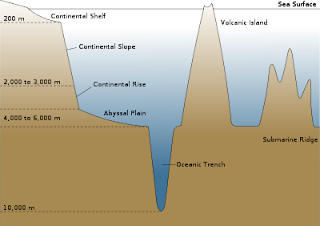The Pacific Ocean has many seamounts, such as volcanoes and flat-topped guyots. In other places, the ocean floor forms a flat, abyssal plain. The abyssal plain covers more than 30 percent of Earth’s surface.

Abyssal plains are flat or very gently sloping areas of the deep ocean basin floor. They are among the Earth's flattest and smoothest regions and the least explored. Abyssal plains cover approximately 40% of the ocean floor and reach depths between 2,200 and 5,500 m (7,200 and 18,000 ft). They generally lie between the foot of a continental rise and a mid-oceanic ridge.
The abyssal plain is formed when the lower crust (sima), is melted and pushed up by the up-welling mantle, reaches the surface at mid-ocean ridges and forms new oceanic crust. This new oceanic crust is mostly basalt and has a rugged topography. The roughness of this topography is a function of the rate at which the mid-ocean ridge is spreading (the spreading rate). Magnitudes of spreading rates vary quite significantly, and are generally broken down into 3 rates (fast, medium and slow). Typical values for fast-spreading ridges are >100 mm/yr, whilst medium-spreading rates are ~60 mm/yr, and slow-spreading ridges are typically <20 mm/yr. Studies have shown that the slower the spreading rate, the rougher the new oceanic crust will be, and vice versa. It is thought this is due to faulting at the mid-ocean ridge when the new oceanic crust was formed. This oceanic crust eventually becomes overlain with sediments, producing the flat appearance.


No comments:
Post a Comment